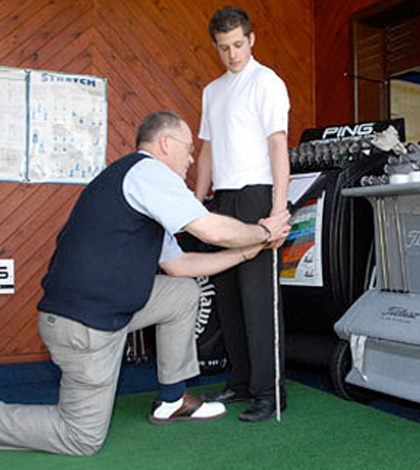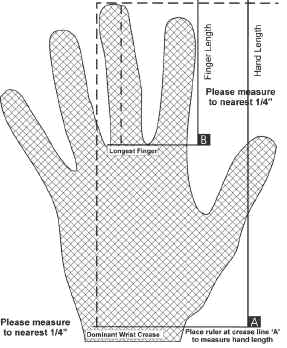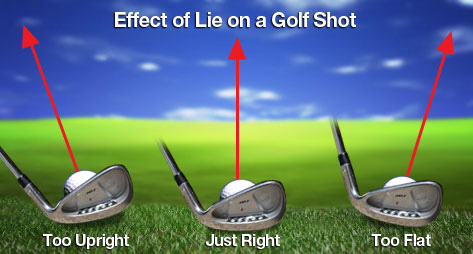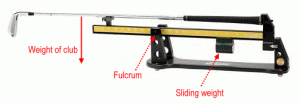Opinion & Analysis
Checking the fit of your clubs on a budget

During the last 17 years, I’ve graduated from the simple regripping of golf clubs to creating full blueprints. Today, when I build clubs for friends and family, I try to leave no stone unturned and work to minimize the variables from club to club. For better golfers, this consistency pays off with a predictable ball flight when you are looking at a shot that requires delicate touch. But does a newer golfer need 100 percent blueprinted clubs? Is that expenditure really going to pay off?
I don’t know about the rest of you, but I’m not swimming in cash. My obsession with putters aside, I have to budget and decide where I am going to spend my dollars. For a lot of golfers, the cost of that fitting or repair may not make sense when they can just apply that cost to buy new clubs. But there are a lot of things you can check without having to visit a shop.
GRIPS
I’ve got big hands. Not ROBOPTI big, but they are pretty meaty. One of the first things I learned was that a larger grip fit my hand better and allowed me to keep control of the club during the swing. I’d suspect that a lot of golfers just play with whatever grip came on the club when they bought it.
Checking for free: Grip the club and look at your hands. The rule of thumb is the tips of your fingers should be lightly touching your palm. If they are not, the grip may be too large for you. If your fingers are digging into your palm, the grip is probably too small.
If you decide you need a change: Now is the time to have your hands measured. Beyond standard, midsize and jumbo, the repair shop can add extra wraps of masking tape as needed to fine-tune the feel. Take the Goldilocks approach and make sure the fit is just right. Grips have different taper rates, so try different brands to get the right combination of taper, feel and tack for you.
Obsessive-compulsive details for WRX members: Just because you have used .600-inch Golf Pride round grips for the last 10 years, understand that not all shafts are .600-inch anymore. Your driver might have a .605-inch up to a .620-inch butt diameter depending on the model. What used to be a perfect on Dynamic Gold will not be the same with PX or C-Taper because the butt section tapers under the grip.
A top-tier clubfitter will measure your grips in two or three areas to make sure you have consistent sizing for both hands of the grip.
CHECK YOUR LIE ANGLES
OEM Online Fitting programs will get your lie angles in the ballpark if you want to order new clubs. But the final step is verifying the measurements against your swing on a lie board. You can see if you need to be more upright or flat while you are at the driving range.
Checking for free: A lot of people hate them, but the range turf mat is your friend in this exercise. I shouldn’t have to state this, but I will anyway: hit off the mat. Don’t hit off the tee! As you hit balls, the green schmutz on the sole of your irons and wedges will tell you if the clubs are too upright or flat for you. Properly struck shots will have the green in the center of the club, or evenly across the entire sole. If you see that the mark is biased towards the heel or toe, it’s time for your clubs to be adjusted.
If you decide you need a change: This is a serious step and you have either an easy choice or a time-consuming choice. The easy way is to let the clubfitter set your lies from a single club, usually a 6- or 7-iron. The clubfitter will see what lie angle you need compared to the reference standard of that set and then adjust the lies accordingly. This is when you will hear people tell you they are “2-degree upright” or “1-degree flat.”
Obsessive-compulsive details for WRX members: The time consuming method is to hit every club on the lie board and adjust each club as needed for your swing. At this point, you will refer to each club by its lie. I have a 61-degree 5-iron, a 64.5-degree 9-iron and a 65-degree sand wedge. My lie progression does not match the factory model and if I just said I was “one-degree up,” my long irons would be too upright.
A good fitter will give you a chart with your lofts/lies when you walk out of the store. You should check these specs against the new clubs you may buy in the future and order your specs accordingly.
Note that loft/length are dependent on each other. The Ping color chart is a good example of this. If your 7-iron is 63 degrees, that lie is based on the length of your current club. If you extend or shorten your clubs, you will want to verify your angles again on the lie board.
CHECK YOUR SWING WEIGHTS
All clubs start their lives as components. Heads, shafts and grips each have specifications and tolerances for angles, lengths and weight. For the majority of the industry, there is a tolerance of plus/minus 2 grams on weights. As a result, the specified swing weight of the club may not match the actual swing weight. One club with a heavy head and light grip can feel radically different compared to the same model with a light head and a heavy grip. Yet both would be “in spec” for a production line built set of clubs.
Checking for free: This one is not completely free, unless you can get access to a swing weight scale. Most club repair shops and big box stores with repair centers should have one. Some driving ranges and pro shops may have a scale as well.
Most golfers, when they think about their clubs, usually have two or three clubs in the bag that they always seem to hit well. There are usually some that always seem to be a struggle. A quick check on the swing weight scale will often times show the good clubs to have a similar swing weight and the tough clubs will be significantly lighter or heavier. When having clubs built for you or repaired, make sure you specify the good swing weight to your club fitter so that they get the club to feel right.
If you decide you need a change: Light clubs can be made heavier by adding lead tape to the club head. Applied to the back of the club near the center of the club head, add mass until the swing weight matches the good clubs. Verify the feel on the range. Heavier clubs can be adjusted by having your clubfitter grind away some weight from the club head. Again, adjust until the swing weight matches the good clubs to give a more consistent feel from club to club. You can get a roll of lead tape at your golf shop for a few dollars. One package is usually enough to raise an entire set of clubs by one swing weight point.
Obsessive-compulsive details for WRX members: Swing weight can be affected by length as well. You may want to have your clubfitter check the lengths of your clubs to ensure consistent spacing between each club. You can also have internal tip weights installed by your clubfitter to match the swing weights and avoid lead tape, which is unsightly to some golfers on their pretty new irons. Grip weights can also change swing weight. The Golf Pride NDMC grips are seven or eight grams lighter than the 50-gram Tour Velvet grip found on a lot of factory clubs. This can move the swing weight up to 1.5 points. A .580-inch core Tour Velvet will also weigh two or three grams more than a .600-inch core Tour Velvet. Midsize will weigh even more than the standard sized grips. Ensure you have consistent grips sizes and weights, especially if you are having your set regripped.
Knowing the specifications that work for you will give you, your teacher and your clubfitter an easy reference to ensure you are getting the best, most consistent performance from every club in your bag.
Click here for more discussion in the “Clubmaking” forum.
- LIKE19
- LEGIT2
- WOW1
- LOL0
- IDHT1
- FLOP1
- OB1
- SHANK2
19th Hole
Vincenzi’s 2024 Zurich Classic of New Orleans betting preview

The PGA TOUR heads to New Orleans to play the 2023 Zurich Classic of New Orleans. In a welcome change from the usual stroke play, the Zurich Classic is a team event. On Thursday and Saturday, the teams play best ball, and on Friday and Sunday the teams play alternate shot.
TPC Louisiana is a par 72 that measures 7,425 yards. The course features some short par 4s and plenty of water and bunkers, which makes for a lot of exciting risk/reward scenarios for competitors. Pete Dye designed the course in 2004 specifically for the Zurich Classic, although the event didn’t make its debut until 2007 because of Hurricane Katrina.
Coming off of the Masters and a signature event in consecutive weeks, the field this week is a step down, and understandably so. Many of the world’s top players will be using this time to rest after a busy stretch.
However, there are some interesting teams this season with some stars making surprise appearances in the team event. Some notable teams include Patrick Cantlay and Xander Schauffele, Rory McIlroy and Shane Lowry, Collin Morikawa and Kurt Kitayama, Will Zalatoris and Sahith Theegala as well as a few Canadian teams, Nick Taylor and Adam Hadwin and Taylor Pendrith and Corey Conners.
Past Winners at TPC Louisiana
- 2023: Riley/Hardy (-30)
- 2022: Cantlay/Schauffele (-29)
- 2021: Leishman/Smith (-20)
- 2019: Palmer/Rahm (-26)
- 2018: Horschel/Piercy (-22)
- 2017: Blixt/Smith (-27)
2024 Zurich Classic of New Orleans Picks
Tom Hoge/Maverick McNealy +2500 (DraftKings)
Tom Hoge is coming off of a solid T18 finish at the RBC Heritage and finished T13 at last year’s Zurich Classic alongside Harris English.
This season, Hoge is having one of his best years on Tour in terms of Strokes Gained: Approach. In his last 24 rounds, the only player to top him on the category is Scottie Scheffler. Hoge has been solid on Pete Dye designs, ranking 28th in the field over his past 36 rounds.
McNealy is also having a solid season. He’s finished T6 at the Waste Management Phoenix Open and T9 at the PLAYERS Championship. He recently started working with world renowned swing coach, Butch Harmon, and its seemingly paid dividends in 2024.
Keith Mitchell/Joel Dahmen +4000 (DraftKings)
Keith Mitchell is having a fantastic season, finishing in the top-20 of five of his past seven starts on Tour. Most recently, Mitchell finished T14 at the Valero Texas Open and gained a whopping 6.0 strokes off the tee. He finished 6th at last year’s Zurich Classic.
Joel Dahmen is having a resurgent year and has been dialed in with his irons. He also has a T11 finish at the PLAYERS Championship at TPC Sawgrass which is another Pete Dye track. With Mitchell’s length and Dahmen’s ability to put it close with his short irons, the Mitchell/Dahmen combination will be dangerous this week.
Taylor Moore/Matt NeSmith +6500 (DraftKings)
Taylor Moore has quickly developed into one of the more consistent players on Tour. He’s finished in the top-20 in three of his past four starts, including a very impressive showing at The Masters, finishing T20. He’s also finished T4 at this event in consecutive seasons alongside Matt NeSmith.
NeSmith isn’t having a great 2024, but has seemed to elevate his game in this format. He finished T26 at Pete Dye’s TPC Sawgrass, which gives the 30-year-old something to build off of. NeSmith is also a great putter on Bermudagrass, which could help elevate Moore’s ball striking prowess.
- LIKE8
- LEGIT3
- WOW1
- LOL1
- IDHT0
- FLOP3
- OB1
- SHANK2
19th Hole
Vincenzi’s 2024 LIV Adelaide betting preview: Cam Smith ready for big week down under

After having four of the top twelve players on the leaderboard at The Masters, LIV Golf is set for their fifth event of the season: LIV Adelaide.
For both LIV fans and golf fans in Australia, LIV Adelaide is one of the most anticipated events of the year. With 35,000 people expected to attend each day of the tournament, the Grange Golf Club will be crawling with fans who are passionate about the sport of golf. The 12th hole, better known as “the watering hole”, is sure to have the rowdiest of the fans cheering after a long day of drinking some Leishman Lager.
The Grange Golf Club is a par-72 that measures 6,946 yards. The course features minimal resistance, as golfers went extremely low last season. In 2023, Talor Gooch shot consecutive rounds of 62 on Thursday and Friday, giving himself a gigantic cushion heading into championship Sunday. Things got tight for a while, but in the end, the Oklahoma State product was able to hold off The Crushers’ Anirban Lahiri for a three-shot victory.
The Four Aces won the team competition with the Range Goats finishing second.
*All Images Courtesy of LIV Golf*
Past Winners at LIV Adelaide
- 2023: Talor Gooch (-19)
Stat Leaders Through LIV Miami
Green in Regulation
- Richard Bland
- Jon Rahm
- Paul Casey
Fairways Hit
- Abraham Ancer
- Graeme McDowell
- Henrik Stenson
Driving Distance
- Bryson DeChambeau
- Joaquin Niemann
- Dean Burmester
Putting
- Cameron Smith
- Louis Oosthuizen
- Matt Jones
2024 LIV Adelaide Picks
Cameron Smith +1400 (DraftKings)
When I pulled up the odds for LIV Adelaide, I was more than a little surprised to see multiple golfers listed ahead of Cameron Smith on the betting board. A few starts ago, Cam finished runner-up at LIV Hong Kong, which is a golf course that absolutely suits his eye. Augusta National in another course that Smith could roll out of bed and finish in the top-ten at, and he did so two weeks ago at The Masters, finishing T6.
At Augusta, he gained strokes on the field on approach, off the tee (slightly), and of course, around the green and putting. Smith able to get in the mix at a major championship despite coming into the week feeling under the weather tells me that his game is once again rounding into form.
The Grange Golf Club is another course that undoubtedly suits the Australian. Smith is obviously incredibly comfortable playing in front of the Aussie faithful and has won three Australian PGA Championship’s. The course is very short and will allow Smith to play conservative off the tee, mitigating his most glaring weakness. With birdies available all over the golf course, there’s a chance the event turns into a putting contest, and there’s no one on the planet I’d rather have in one of those than Cam Smith.

Louis Oosthuizen +2200 (DraftKings)
Louis Oosthuizen has simply been one of the best players on LIV in the 2024 seas0n. The South African has finished in the top-10 on the LIV leaderboard in three of his five starts, with his best coming in Jeddah, where he finished T2. Perhaps more impressively, Oosthuizen finished T7 at LIV Miami, which took place at Doral’s “Blue Monster”, an absolutely massive golf course. Given that Louis is on the shorter side in terms of distance off the tee, his ability to play well in Miami shows how dialed he is with the irons this season.
In addition to the LIV finishes, Oosthuizen won back-to-back starts on the DP World Tour in December at the Alfred Dunhill Championship and the Mauritus Open. He also finished runner-up at the end of February in the International Series Oman. The 41-year-old has been one of the most consistent performers of 2024, regardless of tour.
For the season, Louis ranks 4th on LIV in birdies made, T9 in fairways hit and first in putting. He ranks 32nd in driving distance, but that won’t be an issue at this short course. Last season, he finished T11 at the event, but was in decent position going into the final round but fell back after shooting 70 while the rest of the field went low. This season, Oosthuizen comes into the event in peak form, and the course should be a perfect fit for his smooth swing and hot putter this week.

- LIKE13
- LEGIT3
- WOW1
- LOL1
- IDHT0
- FLOP1
- OB1
- SHANK1
Opinion & Analysis
The Wedge Guy: What really makes a wedge work? Part 1

Of all the clubs in our bags, wedges are almost always the simplest in construction and, therefore, the easiest to analyze what might make one work differently from another if you know what to look for.
Wedges are a lot less mysterious than drivers, of course, as the major brands are working with a lot of “pixie dust” inside these modern marvels. That’s carrying over more to irons now, with so many new models featuring internal multi-material technologies, and almost all of them having a “badge” or insert in the back to allow more complex graphics while hiding the actual distribution of mass.
But when it comes to wedges, most on the market today are still single pieces of molded steel, either cast or forged into that shape. So, if you look closely at where the mass is distributed, it’s pretty clear how that wedge is going to perform.
To start, because of their wider soles, the majority of the mass of almost any wedge is along the bottom third of the clubhead. So, the best wedge shots are always those hit between the 2nd and 5th grooves so that more mass is directly behind that impact. Elite tour professionals practice incessantly to learn to do that consistently, wearing out a spot about the size of a penny right there. If impact moves higher than that, the face is dramatically thinner, so smash factor is compromised significantly, which reduces the overall distance the ball will fly.
Every one of us, tour players included, knows that maddening shot that we feel a bit high on the face and it doesn’t go anywhere, it’s not your fault.
If your wedges show a wear pattern the size of a silver dollar, and centered above the 3rd or 4th groove, you are not getting anywhere near the same performance from shot to shot. Robot testing proves impact even two to three grooves higher in the face can cause distance loss of up to 35 to 55 feet with modern ‘tour design’ wedges.
In addition, as impact moves above the center of mass, the golf club principle of gear effect causes the ball to fly higher with less spin. Think of modern drivers for a minute. The “holy grail” of driving is high launch and low spin, and the driver engineers are pulling out all stops to get the mass as low in the clubhead as possible to optimize this combination.
Where is all the mass in your wedges? Low. So, disregarding the higher lofts, wedges “want” to launch the ball high with low spin – exactly the opposite of what good wedge play requires penetrating ball flight with high spin.
While almost all major brand wedges have begun putting a tiny bit more thickness in the top portion of the clubhead, conventional and modern ‘tour design’ wedges perform pretty much like they always have. Elite players learn to hit those crisp, spinny penetrating wedge shots by spending lots of practice time learning to consistently make contact low in the face.
So, what about grooves and face texture?
Grooves on any club can only do so much, and no one has any material advantage here. The USGA tightly defines what we manufacturers can do with grooves and face texture, and modern manufacturing techniques allow all of us to push those limits ever closer. And we all do. End of story.
Then there’s the topic of bounce and grinds, the most complex and confusing part of the wedge formula. Many top brands offer a complex array of sole configurations, all of them admittedly specialized to a particular kind of lie or turf conditions, and/or a particular divot pattern.
But if you don’t play the same turf all the time, and make the same size divot on every swing, how would you ever figure this out?
The only way is to take any wedge you are considering and play it a few rounds, hitting all the shots you face and observing the results. There’s simply no other way.
So, hopefully this will inspire a lively conversation in our comments section, and I’ll chime in to answer any questions you might have.
And next week, I’ll dive into the rest of the wedge formula. Yes, shafts, grips and specifications are essential, too.
- LIKE36
- LEGIT7
- WOW1
- LOL1
- IDHT2
- FLOP3
- OB1
- SHANK3
-

 19th Hole3 weeks ago
19th Hole3 weeks agoDave Portnoy places monstrous outright bet for the 2024 Masters
-

 19th Hole1 week ago
19th Hole1 week agoJustin Thomas on the equipment choice of Scottie Scheffler that he thinks is ‘weird’
-

 19th Hole3 weeks ago
19th Hole3 weeks agoTiger Woods arrives at 2024 Masters equipped with a putter that may surprise you
-

 19th Hole1 week ago
19th Hole1 week ago‘Absolutely crazy’ – Major champ lays into Patrick Cantlay over his decision on final hole of RBC Heritage
-

 19th Hole2 weeks ago
19th Hole2 weeks agoTwo star names reportedly blanked Jon Rahm all week at the Masters
-

 19th Hole2 weeks ago
19th Hole2 weeks agoReport: LIV Golf identifies latest star name they hope to sign to breakaway tour
-

 19th Hole2 weeks ago
19th Hole2 weeks agoNeal Shipley presser ends in awkward fashion after reporter claims Tiger handed him note on 8th fairway
-

 19th Hole2 weeks ago
19th Hole2 weeks agoBrandel Chamblee has ‘no doubt’ who started the McIlroy/LIV rumor and why



















Nocklaus
Apr 17, 2017 at 9:19 pm
Actually, different gripweights does not affect playability that much. A swingweight measurer, measures the “balance” 14″ from the butt end. But when you hold the club the balance point is just between your hands, about 3″ down and therefore different gripweight affects the club about the same as if you wear a watch or not.
Craig berry
Feb 7, 2013 at 5:38 pm
Going to get fitted in a few weeks by “world club maker” of the year 2010!!!!!
That’s a hefty title…..can’t wait to see what the doctor is going to prescribe for my swing!
Should be worth it in the end! The way forward!
Pingback: Your Search for Golf Club Ends Here - I Trust My Driver | I Trust My Driver
Troy Vayanos
Jan 19, 2013 at 7:59 pm
Thanks for the post Brad,
I never would have thought before to check the grips to see if they were the right thickness. I think most of us golfers just assume it’s a one size fits all situation.
I’ve always had my lie angles checked and of the course the length of the shafts.
It’s interesting to know that it doesn’t stop there.
Cheers